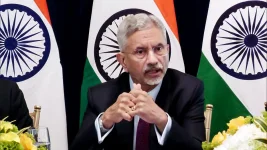- Views: 2K
- Replies: 9
Recent reports from defence circles indicate that the Pakistan Air Force (PAF) may have granted Chinese engineers access to modify its fleet of European-made Saab 2000 Erieye surveillance aircraft.
The primary objective of this collaboration is reportedly to make the advanced Swedish system compatible with Pakistan's Chinese-manufactured JF-17 and J-10CE fighter jets, a move that has sparked serious concerns about the potential for technology theft and the security of sensitive Western military systems.
At the heart of the issue is a fundamental technological barrier. The Saab 2000, a sophisticated Airborne Early Warning and Control (AEW&C) aircraft often called an "eye-in-the-sky," uses a NATO-standard communication system known as Link-17.
This system is inherently incompatible with the different datalinks used by the PAF's modern Chinese fighters. This communication gap prevents the aircraft from sharing critical real-time data, a function essential for modern networked warfare, such as guiding long-range missiles to their targets or coordinating a unified air defence.
The Saab 2000 Erieye is a vital component of Pakistan's air defence network. Equipped with a powerful Active Electronically Scanned Array (AESA) radar, it provides 270-degree surveillance and can detect aerial threats up to 450 kilometres away.
PAF operates a fleet of these aircraft, though its numbers were diminished following the loss of two planes during India's "Operation Sindoor" in May 2025. One was reportedly downed by an Indian S-400 missile deep inside Pakistan, and another was destroyed in a missile strike on an airbase.
To bridge the communication gap, reports suggest that Chinese engineers are assisting the PAF in modifying the Saab aircraft. Such an operation would likely require sharing the Erieye’s highly sensitive technical specifications with China.
This has raised alarms among international observers, who fear that access to the system's architecture could allow China to reverse-engineer the technology or develop electronic countermeasures against it. Such a development could undermine the operational security of other nations that use the same or similar European technology.
Further enhancing the aircraft's capabilities, the PAF’s Saab 2000 platforms are also believed to have been fitted with Chinese CHL-906 electronic warfare (EW) systems.
An EW suite is designed to disrupt, deceive, or deny the enemy's use of the electromagnetic spectrum, providing functions like radar jamming and communications interception. The integration of the CHL-906 significantly boosts the aircraft's ability to protect itself and control the electronic battlespace.
The effectiveness and vulnerabilities of this integrated network were reportedly tested during recent India-Pak conflict. In these engagements, the modified AEW&C aircraft were used to coordinate the PAF's J-10CE and JF-17 jets with ground-based air defences.
The aircraft allegedly guided long-range Chinese PL-15E missiles toward Indian jets, although reports indicated these missiles were successfully neutralised by Indian electronic countermeasures.
Despite the apparent advantages of a hybrid force blending Western and Chinese technology, the conflict also exposed significant risks. The loss of two high-value Saab 2000 aircraft to Indian S-400 and BrahMos missiles highlighted the vulnerability of the fleet.
Reports also emerged that an attempt by the PAF to shield one of its AEW&C aircraft by flying it among commercial air traffic was ultimately unsuccessful against India's advanced air defence systems.
For Pakistan, this strategic pivot toward deeper integration with Chinese technology signals an effort to create a seamless and interoperable fighting force.
However, this path risks not only potential diplomatic fallout with its Western defence suppliers like Sweden's Saab but also a growing over-reliance on a single nation for its military hardware.
In contrast, for India, the events underscored the effectiveness of its own air defence network and the importance of continued investment in indigenous systems, such as its Netra AEW&C aircraft and counter-EW technologies, to maintain a strategic advantage.


